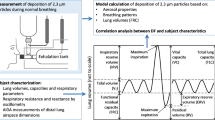Abstract
The dose delivered to airway cells is a critical factor whether one is addressing the therapeutic (i.e., positive) effects of inhaled pharmacologic agents or the toxic (i.e., negative) effects of pollutants. In this study, theoretical models describing particle deposition have been compared with experimental data from the literature. In the simulations, airways can be either roughor smooth-walled to be consistent with human lungs which can be either lined by cartilaginous rings (i.e., rough) or muscle (i.e., smooth). Particle motion for rough-walled airways within generations I=1–6 is calculated using the formula proposed by Martonen et al. (1). For smooth-walled airways within generations I=7–10, particle motion is calculated using the formula proposed by Martonen et al. (2). Theoretical predictions of particle deposition efficiencies are not only in agreement with the overall best fit empirical correlation presented by Cohen and Asgharian (3) over a wide range of dimensionless diffusion parameters, but also match individual experimental measurements (only available in I=1–6) with regard to effects of the parameters of particle size, flow rate, and airway dimensions. The mean difference in the ratio of experimental-to-theoretical particle diffusion values is 0.9 for a flow rate of 18 L/min and 1.1 for a flow rate of 34 L/min (i.e., the difference is only about 10%) within the upper airways of the casts (airway generations I=1–6), the mean difference for the whole casts was much greater. This may be attributed to the uncertainty of flow conditions in the peripheral airways as a result of the trimmmed nature of the casts. Overall, the findings suggest that the model can be a valuable component of aerosol therapy and risk assessment protocols, especially to address effects of enhanced deposition of pharmacologic drugs and radionuclides at sites within the human tracheobronchial tree.
Similar content being viewed by others
References
Martonen, T., Zhang, Z., and Yang, Y. (1996) Particle diffusion from developing flows in rough-walled tubes.Aerosol Sci. Technol., in press.
Martonen, T., Zhang, Z., and Yang, Y. (1996) Particle diffusion with entrance effects in a smooth-walled cylinder.J. Aerosol. Sci. 27, 139–150.
Cohen, B. S. and Asgharian, B. (1990) Deposition of ultrafine particles in the upper airways: an empirical analysis.J. Aerosol Sci. 21, 789–797.
Martonen, T., Zhang, Z., Yang, Y., and Bottei, G. (1995) Airway surface irregularities promote particle diffusion in the human lung.Rad. Prot. Dosim. 59, 5–14.
Martonen, T. and Zhang, Z. (1996) Deposition of ultrafine aerosols in human tracheobronchial airways.Inhal. Toxicol., in press.
Cohen, B. S., Sussman, R. G., and Lippmann, M. (1990) Ultrafine particle deposition in a human tracheobronchial cast.Aerosol Sci. Technol. 12, 1082–1091.
Ingham, D. B. (1975) Diffusion of aerosols from a stream flowing through a cylindrical tube.J. Aerosol Sci. 6, 125–132.
Martonen, T., Yang, Y., and Xue, Z. (1994) Influences of cartilaginous rings on tracheobronchial fluid dynamics.Inhal. Toxicol. 6, 185–203.
Author information
Authors and Affiliations
Additional information
Disclaimer: This manuscript has been reviewed in accordance with the policy of the National Health and Environmental Effects Research Laboratory, US Environmental Protection Agency, and approved for publication. Approval does not signify that the contents necessarily reflect the views and policies of the agency, nor does mention of trade names or commercial products constitute endorsement or recommendation for use.
Rights and permissions
About this article
Cite this article
Zhang, Z., Martonen, T. Comparison of theoretical and experimental particle diffusion data within human airway casts. Cell Biochem Biophys 27, 97–108 (1995). https://doi.org/10.1007/BF02815400
Issue Date:
DOI: https://doi.org/10.1007/BF02815400




